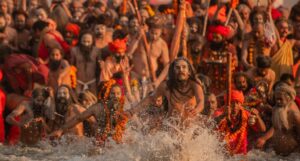Maha Kumbh Mela
The Maha Kumbh Mela is the largest and most significant religious gathering in the world, drawing millions of devotees from all over India and beyond. Held once every 12 years at one of four sacred locations in India — Prayagraj (Allahabad), Haridwar, Ujjain, and Nashik — the event is a grand celebration of faith, spirituality, and culture.
Rooted in ancient Hindu mythology, the Kumbh Mela marks the mythical churning of the ocean (Samudra Manthan) during which the amrit (nectar of immortality) was spilled at these four locations. For devotees, the act of bathing in the holy rivers during the Mela is believed to cleanse the soul, wash away sins, and help attain moksha (liberation). The Maha Kumbh Mela, held in Prayagraj, is considered the most auspicious of all, attracting the largest number of pilgrims.
The Mela is not just a religious event; it’s a vibrant cultural spectacle, filled with processions, prayers, spiritual discourses and rituals. It’s a place where faith, devotion and human unity come together in a celebration that transcends boundaries and brings people closer to their spiritual essence. Whether you’re seeking a deep connection with your spirituality or simply curious to witness this extraordinary event, the Maha Kumbh Mela offers a transformative experience like no other.
Why did it call as Maha Kumbh Mela?
The term “Maha Kumbh Mela” is derived from both “Kumbh” and “Maha,” each holding significant meaning in Hindu tradition.
-
 Kumbh: The word Kumbh translates to pot or pitcher in Sanskrit. In Hindu mythology, it is linked to the story of the Samudra Manthan (churning of the ocean). According to the myth, during the churning, the gods and demons fought to obtain the amrit (nectar of immortality). The nectar was carried away in a kumbh (pitcher), and during the battle a few drops of this divine nectar fell at four locations: Prayagraj (Allahabad), Haridwar, Ujjain, and Nashik. These four places are considered sacred and the event where pilgrims gather to bathe in the holy rivers at these locations is known as the Kumbh Mela.
Kumbh: The word Kumbh translates to pot or pitcher in Sanskrit. In Hindu mythology, it is linked to the story of the Samudra Manthan (churning of the ocean). According to the myth, during the churning, the gods and demons fought to obtain the amrit (nectar of immortality). The nectar was carried away in a kumbh (pitcher), and during the battle a few drops of this divine nectar fell at four locations: Prayagraj (Allahabad), Haridwar, Ujjain, and Nashik. These four places are considered sacred and the event where pilgrims gather to bathe in the holy rivers at these locations is known as the Kumbh Mela. -
Maha: The word Maha means great or grand. It signifies the larger more significant version of the Kumbh Mela, held once every 12 years at the Prayagraj location. The Maha Kumbh Mela is considered the most auspicious and spiritual of all the Kumbh Melas. It is the peak of all the Kumbh gatherings, attracting the largest number of devotees and participants. The significance of the “Maha” highlights the extraordinary spiritual importance of the event.
In essence, the Maha Kumbh Mela is the “Great Kumbh Mela,” marking the most significant and grandest gathering of devotees, sadhus (ascetics), and pilgrims, drawn to bathe in the holy rivers to cleanse their souls and gain spiritual merit.
What is the Maha Kumbh Mela?
The Maha Kumbh Mela is a Hindu pilgrimage festival that takes place at four major locations in India: Allahabad (Prayagraj), Haridwar, Ujjain and Nashik. The festival rotates every 12 years between these locations with the Maha Kumbh Mela held at Prayagraj (formerly Allahabad) every 12th year in a 144-year cycle. This is the largest and most important gathering in the Kumbh Mela series.
The festival’s name comes from the Kumbh, a vessel in Hindu mythology that holds the nectar of immortality. The Kumbh Mela is believed to be a time when the amrita (nectar) spilled from the Kumbh during a cosmic battle between gods and demons. The river where the nectar fell is said to have divine powers and bathing in its waters is believed to purify the soul and grant salvation.
Significance of the Maha Kumbh Mela
 The Maha Kumbh Mela holds profound religious and cultural significance. For Hindus, taking a holy dip in the river during this time is considered the ultimate act of devotion. The Mela is believed to wash away sins, bring spiritual merit and lead to moksha (liberation). The event is also a celebration of community, spirituality, and unity.
The Maha Kumbh Mela holds profound religious and cultural significance. For Hindus, taking a holy dip in the river during this time is considered the ultimate act of devotion. The Mela is believed to wash away sins, bring spiritual merit and lead to moksha (liberation). The event is also a celebration of community, spirituality, and unity.
Devotees believe that during the Mela, the river’s waters are imbued with special powers due to the cosmic alignment of planets, making it an auspicious time for prayer and purification.
When and Where is the Maha Kumbh Mela Held?
The Maha Kumbh Mela is held every 12 years in Prayagraj (Allahabad), with the next one scheduled for 2025. The last Maha Kumbh Mela took place in 2013. The festival is celebrated over a period of around 6-8 weeks, typically beginning in January and ending in March, with the most auspicious dates being decided based on Hindu astrology.
The festival also features several Shahi Snan (royal baths), where thousands of devotees take dips in the river at specific, astrologically significant moments. The most significant bath usually takes place on Makar Sankranti, when the sun is in Capricorn, marking the start of the most spiritually significant period of the festival.
Key Rituals and Activities at the Maha Kumbh Mela
-
Taking the Holy Dip: The central ritual of the Kumbh Mela is the holy dip in the river. Devotees believe that bathing in the sacred waters during the festival will cleanse them of their sins and grant spiritual benefits. The Kumbh Mela sees millions of people bathing at the same time, making it an awe-inspiring spectacle.
-
2.
 Puja and Prayers: Devotees participate in various forms of puja (prayers) to seek blessings, perform rituals to their ancestors and express their devotion to Lord Shiva, Lord Vishnu, and other deities.
Puja and Prayers: Devotees participate in various forms of puja (prayers) to seek blessings, perform rituals to their ancestors and express their devotion to Lord Shiva, Lord Vishnu, and other deities. -
Satsangs and Discourses: Religious leaders and spiritual gurus offer satsangs (spiritual discourses) and teachings during the Mela. This provides a platform for people to deepen their spiritual knowledge and understand the teachings of various Hindu philosophies.
-
Brahminical Rituals and Aartis: The prominent aartis (devotional songs) and yajnas (sacrificial offerings) are an integral part of the Mela. Devotees join together in the evening to sing aartis to deities, creating a harmonious, devotional atmosphere.
-
Naga Sadhus and the Akharas: A unique and notable feature of the Mela is the presence of the Naga Sadhus—ascetic monks who have renounced worldly life. They are known for their distinctive appearance, which includes ash smeared on their bodies and are considered highly revered for their spiritual practices. The Naga Sadhus belong to different Akharas (spiritual sects) and each Akhara participates in the royal bath processions, creating a breathtaking visual experience.
Cultural Aspects of the Maha Kumbh Mela
Apart from the religious aspects, the Maha Kumbh Mela is also a grand cultural celebration. The Mela attracts thousands of artists, performers, and cultural enthusiasts, turning the event into a vibrant carnival of colors, music and dance. Traditional folk performances, dances and storytelling are a part of the Mela, with performances celebrating the rich cultural heritage of India.
Local and international food stalls offer a wide variety of traditional Indian dishes and beverages allowing people to savor regional flavors. In addition, one can find spiritual merchandise, books and artifacts for sale.
Maha Kumbh Mela in Modern Times
In the modern era, the Maha Kumbh Mela is not only a religious event but also a significant tourist attraction. The gathering has grown beyond just a spiritual pilgrimage, attracting visitors from different parts of the world to witness this grand spectacle. The Indian government and local authorities make extensive arrangements for infrastructure, sanitation, transportation and safety to handle the massive crowds that attend the Mela.
Challenges and Precautions
Given the sheer scale of the event, safety and security become a primary concern during the Mela. The festival attracts millions of people and there are risks related to crowd management, health issues and logistics. However, authorities ensure that measures are in place to help keep the event as safe and organized as possible.
Additionally, pilgrims must exercise caution and take care of their personal belongings, as the Mela is a crowded and chaotic event. It’s also important to stay hydrated, as large gatherings under the sun can cause fatigue.
Conclusion: The Spiritual Glory of the Maha Kumbh Mela
The Maha Kumbh Mela is more than just a religious event; it is a profound expression of spirituality, unity and devotion. It’s a moment where millions come together in the hope of purifying their soul, seeking peace and finding answers to life’s biggest questions. Whether you are a believer or not, the sheer scale and significance of the Maha Kumbh Mela make it a must-see spectacle that touches the hearts of those who attend.
If you’re ever in India during the Kumbh Mela, it’s an experience that will stay with you for a lifetime, transcending mere religion and becoming a celebration of humanity’s collective spiritual quest.
more information https://yesnearme.com/news


Hello Manoj, This is Piyush. I just read your article on maha Kumbh Mela this one is very awesome and helps people to know more about Indian culture and traditions. It will also describe India’s one of the biggest Hindu tradition i.e Kumbh Mela. I would also interested in reading this type of topic.
Thank you.
Hello Manoj,
This is Archana. I read your article as per me your share very important information with us because people know about Kumbh Mela but don’t know how to reach there.
you have simplified and given a good solution to reach at this place.
Thank u!!!